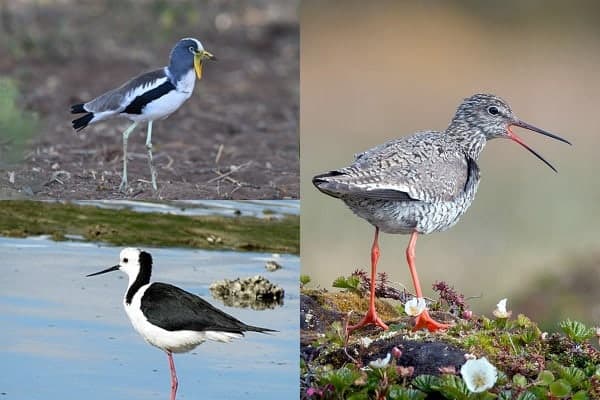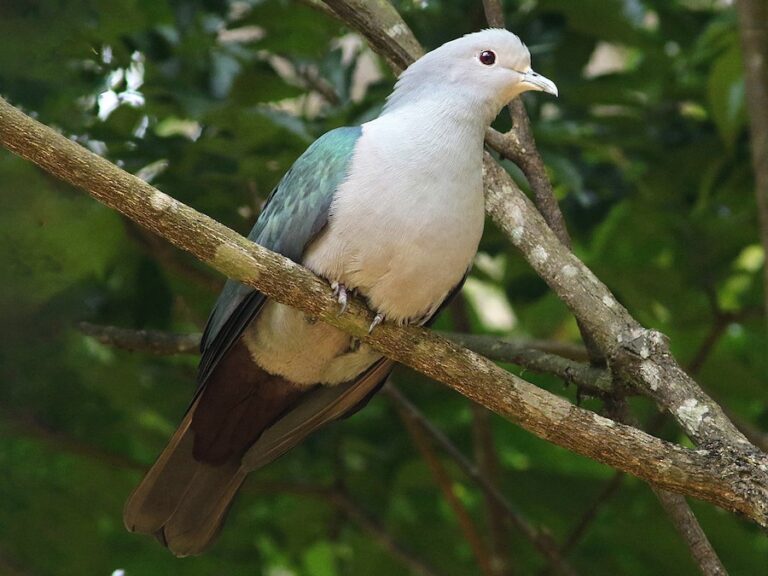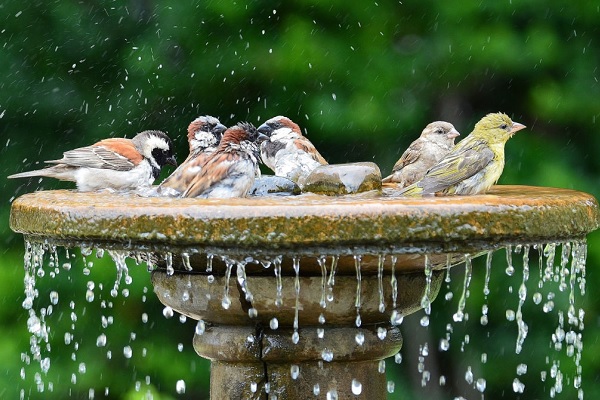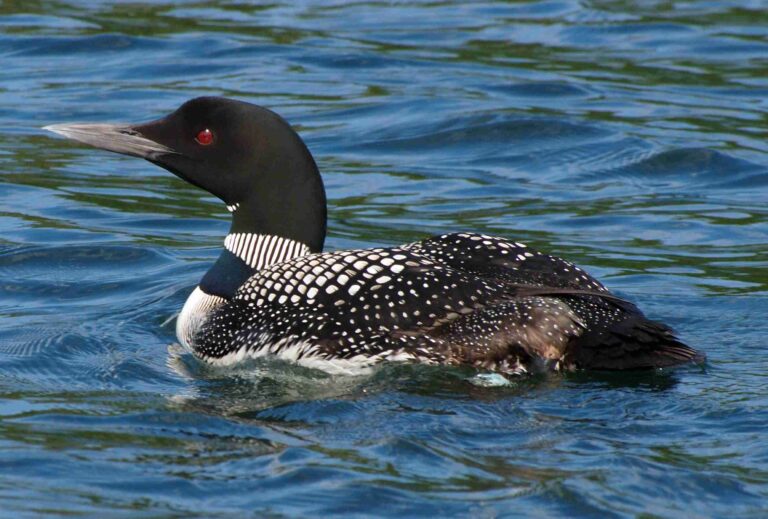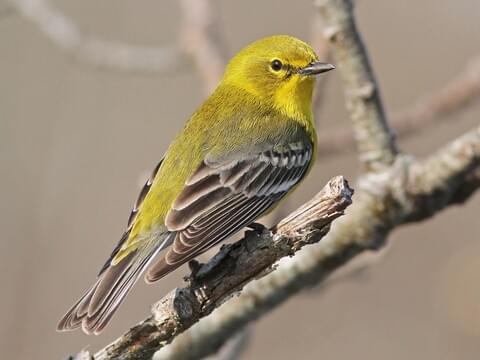Small Birds with Long Legs: 10 Graceful Species With Photos
In this article, we will take a closer look at small birds with long legs, highlighting 10 graceful species found in North America. The solitary birds are usually found near water bodies. bird species with long legs to wade in shallow waters birds have unique adaptations that allow them to thrive in various habitats, such as tall grasses and shallow waters. Join us as we explore the fascinating world Considering the world of the 13 birds with long legs, habitat diversity becomes critical for elegant and agile creatures.
Key Takeaways
- Small birds with long legs are prevalent in North America, with unique adaptations for specific habitats.
- These birds thrive in environments such as tall grasses and shallow waters.
- Some of the species featured are the reddish egret, greater flamingo, and black-tailed godwit.
- Their long long legs are an adaptation that enables them to navigate various terrains with ease. them to wade through water and search for prey.
- Exploring the behavior and characteristics of these birds offers insight into their survival strategies.
Why Do Some Birds Have Long Legs?
Many bird species possess long legs that help them to wade in water for various reasons. These adaptations enable them to navigate different environments and engage in specialized behaviors. Some birds, such as the great blue heron and secretary bird, one of the 13 birds with long legs, have adapted to diverse habitats., they have long legs that aid in wading through water or tall vegetation.
“Long-legged birds have evolved to thrive in specific habitats,” explains Dr. Sarah Johnson, an ornithologist at the National Avian Research Institute. She further adds, “The great blue heron, for example, uses its long legs to stealthily stalk its prey in shallow water, while the secretary bird has long legs to traverse the vast savannas of Africa.”
The great blue heron, scientifically known as Ardea herodias, is a common bird in North America and is easily identified by its long legs and neck. With its sharp beak and patient hunting style, it can catch fish, frogs, and even small mammals with ease. Additionally, the secretary bird, Sagittarius serpentarius, is a bird with long, sturdy legs primarily found in Africa. These magnificent birds use their long legs to stomp on their prey, including snakes, small mammals, and insects.
Adaptive Advantages of Long Legs
The evolution of long legs in birds provides several key advantages. Firstly, long legs enable Birds to inhabit resources that would be beyond the reach of many other species. For example, the world of birds with long legs is diverse. great blue herons can effortlessly wade through shallow waters, searching for fish and other aquatic prey. Similarly, the secretary bird’s long legs allow it to navigate tall grasses and hunt down its preferred prey items.
Secondly, long legs aid in thermoregulation and provide stability while foraging. By elevating themselves above the ground, birds can avoid the sweltering heat or cold of their surroundings. This advantage is increasingly critical in environments with extreme temperatures where birds inhabit. The long, slender structure of the legs also contributes to enhanced balance and agility, facilitating graceful movements and intricate feeding behaviors.
According to Dr. Johnson, many long-legged birds have adapted distinct foraging behaviors. “Birds with long legs possess a unique advantage in their respective habitats, allowing them to exploit available resources and thrive amidst competition.“
In summary, the long-legged adaptations seen in birds like the great blue heron and secretary bird are the result of natural selection and enable these species to excel in their given ecosystems. From wading through water to traversing tall vegetation, their long legs provide numerous benefits that contribute to their survival and success as specialized hunters.
| Bird Species | The birds inhabit a variety of habitats. is Essential for Long Legged Birds | Main Food Source |
|---|---|---|
| Great Blue Heron | Wetlands, rivers, and coastlines | Fish, frogs, small mammals |
| Secretary Bird | Savannas and grasslands | Snakes, small mammals, insects |
Small Birds with Long Legs in North America
North America is home to several species of small birds with long legs. These graceful birds are commonly found near shallow waters, where they elegantly wade and search for small fish and other aquatic prey. Let’s explore some of the remarkable species that inhabit this region.
American Avocet
The American Avocet (Recurvirostra americana, a large wading bird known for its long beak.) is a striking bird species with long, slender legs and an upward-curving beak. This wading bird is often found in marshes and shallow lakes throughout North America. With its delicate balance and precise movements, the American Avocet skillfully forages for small invertebrates, insects, and crustaceans in shallow waters.
Black-Necked Stilt
The Black-Necked Stilt (Himantopus mexicanus) is a stunning long-legged bird species commonly found in wetlands and coastal areas of North America. With its black and white plumage and incredibly long legs, this wading bird effortlessly navigates through shallow water as it searches for small fish, insects, and crustaceans, all potential food items for the large wading bird with long legs.
Spotted Sandpiper
The Spotted Sandpiper (Actitis macularius) is a small shorebird known for its distinctive behavior and long legs. Found near freshwater shores across North America, this bird intricately walks along the water’s edge, constantly bobbing its tail. Its long legs enable Long legs help it to skillfully traverse through rocky terrain and shallow waters as it feeds on small crustaceans. small fishMany long-legged birds feed on insects and crustaceans.
| Species | Scientific Name | Habitat | The diet of the bird is also very diverse. |
|---|---|---|---|
| American
Avocet |
Recurvirostra
americana |
Marshes,
shallow lakes |
Small invertebrates, insects, crustaceans |
| Black-Necked Stilt | Himantopus
mexicanus |
Wetlands,
coastal areas |
Small fish, insects, and crustaceans – all
part of the diet for bird species with long legs to wade in water. |
| Spotted
Sandpiper |
Actitis
macularius |
Freshwater shores | Small fish, insects, crustaceans |
The Elegance of Egrets: White-Crowned Lapwing, Common Redshank, and Pied Stilt.
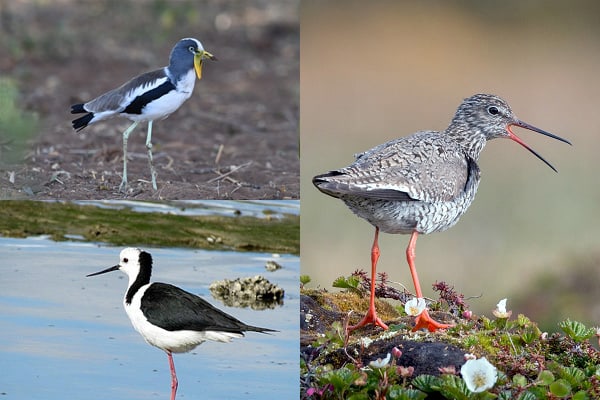
Egrets are known for their graceful appearance and long-legged adaptability. These elegant birds can be found across North America, showcasing their impressive characteristics and behaviors. Let’s explore some of the remarkable egret species that inhabit this region:
- Reddish Egret: The reddish egret, with its beautiful reddish-brown plumage, is a captivating sight in wetland areas. This species is known for its acrobatic displays, as it gracefully moves through shallow waters in search of small invertebrates.
- Purple Heron: With its majestic appearance and distinctive purple-gray plumage, it is a true spectacle. These birds can often be found wading in marshes and ponds, using their long legs to hunt for small prey.
- Black-Tailed Godwit: The black-tailed godwit is a stunning bird with a long, slender bill and unique black and white plumage. These graceful creatures can be seen in coastal areas, mudflats, and wetlands, where they forage for small invertebrates.
- Red-wattled lapwing, a bird species with long legs utilized for wading.: The red-wattled lapwing, showcasing its long legs that help it wade in aquatic habitats. is a charming bird with a striking red beak The bird has long pink legs and wattles. These small wading birds can be found near water bodies, where they feed on small insects and invertebrates.
Each of these egret species adds to the diverse ecosystem of North America, playing a vital role in maintaining the balance of their habitats.
Comparison of Egret Species
| Egret Species | Appearance | Habitat | Feeding Behavior |
|---|---|---|---|
| Reddish Egret | Reddish-brown plumage | Wetlands and marshes | Feeds on small invertebrates |
| Purple Heron | Purple-gray plumage | Marshes and ponds | Hunts for small prey |
| Black-Tailed Godwit | Black and white plumage | Coastal areas | Forages for small invertebrates |
| Red-Wattled
Lapwing |
Red beak and wattles | Near water bodies | Feeds on small insects |
The Majestic Greater Flamingo: A Pink Wonder.
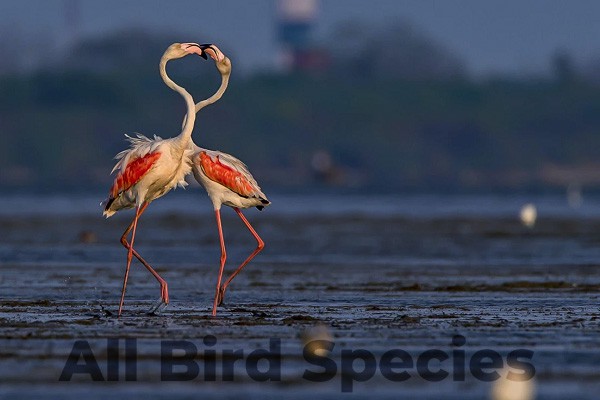
Witness the awe-inspiring beauty of the greater flamingo, a truly majestic bird adorned with striking pink plumage. These graceful creatures are famous for their long, slender legs, which set them apart from other avian species. They can be found in a variety of habitats, but are particularly drawn to shallow water areas, where they embark on a captivating search for food.
The legs of the great blue heron, a prominent feature of this species, play a crucial part in their foraging behavior. In the shallow waters they inhabit, these elegant birds skillfully utilize their lengthy appendages to their advantage. With meticulous precision, they gracefully wade through the water, using their legs to stir up sediment and uncover small organisms, such as crustaceans and tiny shrimp, as well as algae and aquatic plants, which form an essential part of their diet.
“These remarkable birds have evolved to thrive in their watery habitats, utilizing their long legs as invaluable tools in the pursuit of nourishment.“
It’s not just about feeding though. The greater flamingos’ long legs also aid in cooling their bodies. By standing in the water, they can dissipate excess heat and regulate their body temperature more effectively, thanks to the cooling properties of the water and the increased surface area provided by their long legs.
Another fascinating aspect of the long legs that enable these birds to wade in water. the greater flamingo is its lustrous white feathers on a large wading bird with long legs that help it wade through water bodies., which contrast beautifully with its pink plumage. These white feathers The bird’s long pink legs do not only add to their remarkable appearance but also serve a practical purpose. They help protect the birds from the harsh ultraviolet rays of the sun, reflecting the light away and reducing the risk of sunburn.
So, the next time you spot a greater flamingo elegantly striding through shallow waters with its vibrant pink feathers and long legs, take a moment to admire the extraordinary adaptations that make this bird a true natural wonder.
The Enigmatic Royal Spoonbill
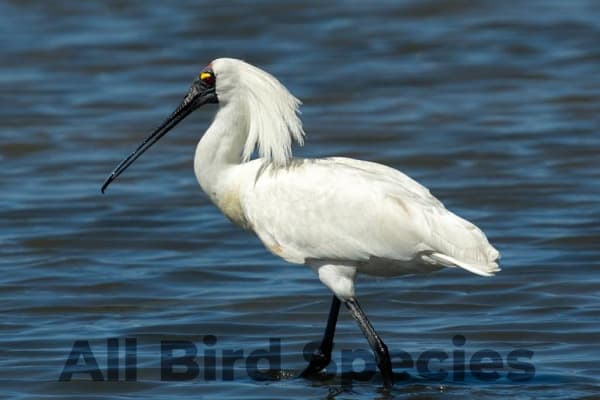
The royal spoonbill is a fascinating bird known for its long neck, distinctive appearance, and remarkable hunting abilities. With their long legs and necks, these birds are formidable hunters, utilizing their unique features to their advantage.
Astonishing Adaptations
The long neck of the royal spoonbill allows it to reach deep into the water and marshlands, probing for small prey hidden beneath the surface. With their slender and agile legs, these birds can effortlessly navigate through various habitats, including shallow waters and mudflats.
“The royal spoonbill is a master at using their long legs to their advantage, allowing them to wade through water and locate small prey with ease.”
This bird has a remarkable ability to use its feet effectively during hunting. While submerged in water, the royal spoonbill uses its legs to stir up the sediment at the bottom, disturbing fish, crustaceans, and other small aquatic creatures. It then snaps its specialized bill shut, capturing its unsuspecting prey.
A Skilled Hunter
The royal spoonbill primarily feeds on small prey, such as fish, crustaceans, and insects. Its long legs play a crucial role in securing a successful meal. The bird’s slender legs allow their long legs allow it to move stealthily through the water, minimizing any disturbances that could alert its prey, such as small crustaceans.
Once the royal spoonbill spots its target, it uses its legs to maintain balance and stability while striking its prey with precision. The bird’s sharp bill acts as a makeshift spoon, scooping up its catch and showcasing its remarkable feeding technique.
A Spectacular Sight
With their elegant appearance and remarkable hunting prowess, royal spoonbills never fail to captivate birdwatchers and nature enthusiasts. Their long necks and legs give them a unique air of grace as they navigate their watery habitats.
Whether observed individually or in flocks, these birds are a true marvel to behold. Their beauty and skill make them an enchanting addition to the avian world.
Discover the Royal Spoonbill
If you’re lucky enough to spot a royal spoonbill in the wild, take a moment to appreciate its unique features and hunting techniques. These birds offer a glimpse into the incredible adaptability and diversity of the avian kingdom.
Stay tuned as we continue our exploration of small birds with long legs, uncovering more fascinating species and the secrets behind their distinctive characteristics.
The Acrobatic Reddish Egret: A Master of the Wetlands.
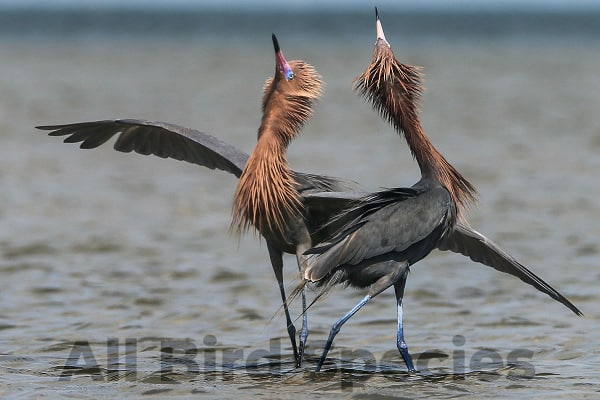
The reddish egret is a captivating bird renowned for its graceful and acrobatic displays in wetland areas. Let’s explore the unique characteristics and behaviors that make this species truly remarkable.
The reddish egret possesses exceptionally long legs that enable the tallest bird in North America to wade through water. legs, which allow it to navigate through shallow waters with ease. These powerful legs Pink legs enable the bird to wade through various terrains, from marshes to lagoons, in search of its prey which includes small crustaceans. Whether hopping on one leg or engaging in elaborate dances, the reddish egret’s legs are crucial in its agile movements.
In addition to its long legs, the reddish egret also boasts a long bill and a distinctive head and neck. This combination of features enables the bird to effectively hunt for fish, shrimp, and other small aquatic creatures. With its lengthy bill, the reddish egret can swiftly snatch prey from the water’s surface, showcasing its impressive hunting skills.
The reddish egret’s exceptional physical attributes, including its long legs and bill, enable it to thrive in wetland environments, becoming a true master of the shallow waters.
This adaptable bird, a large wading bird with long legs, not only relies on them for movement and hunting in water bodies but also employs them during courtship displays. The reddish egret’s vibrant plumage and agile movements, accentuated by its powerful legs and unique feeding behaviors, make it an enthralling sight to behold in the wetlands.
To summarize, the reddish egret stands out among its avian counterparts with its exceptionally long legs, enabling it to navigate and wade through shallow waters effortlessly. Coupled with its long bill and powerful leg muscles, these unique features make the reddish egret a mesmerizing acrobat of the wetlands.
Reddish Egret Features:
| Physical Features of Long-Legged Birds | Behaviors of these solitary birds |
|---|---|
| Exceptionally long legs | Acrobatic hunting displays |
| Long bill | Courtship dances |
| Distinctive head and neck | Adaptable feeding behaviors |
The Agile Black-Tailed Godwit: Master of Long-Distance Travel.
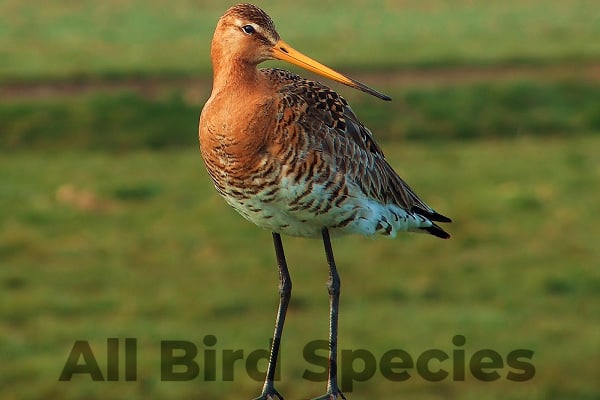
The black-tailed godwit is an incredible bird that possesses remarkable adaptability and excels in long-distance travel. With its long black legs and distinct appearance, this species can be found in tall grasses and shallow waters, utilizing its long legs to search for food and navigate its surroundings.
These birds showcase a stunning contrast, with their white feathers and black legs standing out against the natural backdrop. This unique combination not only serves as a visual spectacle but also plays a crucial role in their survival and hunting strategies.
The black-tailed godwits, a species of birds with long legs, are highly skilled at utilizing these legs to wade through and forage for food in shallow waters. With their slender beaks, they can easily capture small invertebrates and insects that reside in the water or in the wetland areas where they frequent. Their long legs allow them to wade through the water effortlessly, ensuring a successful hunt.
One of the most remarkable aspects of the black-tailed godwit is its impressive migratory behavior. These birds undertake extensive journeys, covering thousands of miles, to reach their breeding and wintering grounds. They embark on these long-distance travels with astounding precision, navigating across vast bodies of water and diverse landscapes.
During their migratory flights, black-tailed godwits rely heavily on their long legs. These adaptations allow them to rest and feed in shallow water areas along their journey, enabling them to sustain their energy levels for the arduous flight ahead. They strategically utilize the resources provided by wetlands and other habitats, ensuring their successful migration.
In conclusion, the black-tailed godwit is a true marvel of nature. Its black legs, white feathers, and utilization of tall grass and shallow water habitats exemplify its adaptability and survival skills. These agile birds embark on impressive migratory journeys, relying on their long legs to navigate various terrains along the way. The black-tailed godwit serves as a testament to the wonders of the avian world and the incredible abilities of our feathered friends.
Small Birds with Long Legs in India: The Comb-Crested Jacana and Red-Wattled Lapwing.
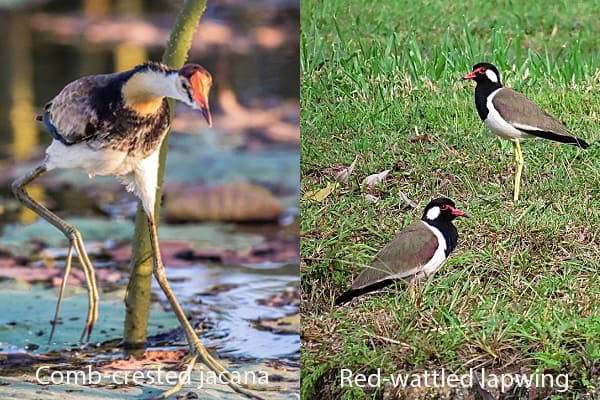
India is a treasure trove of diverse bird species, and among them is the charming comb-crested jacana, a long-legged bird, that uses its legs to move stealthily through the water. and the striking red-wattled lapwing. These small birds with long legs have adapted to various habitats, becoming icons of the country’s rich avian biodiversity.
The comb-crested jacana, scientifically known as Irediparra gallinacea, is characterized by its unique crest of feathers on its head, resembling a beautifully crafted comb. This bird utilizes its long legs to navigate the intricate maze of water lilies and floating vegetation in wetland areas.
On the other hand, the red-wattled lapwing, or Vanellus indicus, is an intriguing species with a distinctive call, striking plumage, and yellow legs that allow it to wade. With long legs specially designed for walking and wading through shallow waters, these birds, including 10 birds with long legs and yellow legs, can be found in various habitats across India, including wetlands, grasslands, and agricultural fields.
Both the comb-crested jacana The secretary bird and the red-wattled lapwing showcase the remarkable adaptability of small birds with long legs, each pair inches long. They have demonstrated their resilience in diverse environments, making them a delight for birdwatchers and nature enthusiasts who are captivated by their beauty and elegance.
Frequently Asked Questions
Q1: What is a small bird with long legs?
The Killdeer is a small bird with long legs.
Q2: What is the name of the bird with the longest legs?
The Sarus Crane holds the record for the bird with the longest legs.
Q3: Which bird has long and very thin legs?
The Stilt Sandpiper is known for its long and thin legs.
Q4: What is a flightless bird with long legs?
The Ostrich is a flightless bird with long legs, known for its incredible running speed.
Q5: What is a pink bird with long legs?
The Roseate Spoonbill is a pink bird with long legs, characterized by its distinctive spoon-shaped bill.

